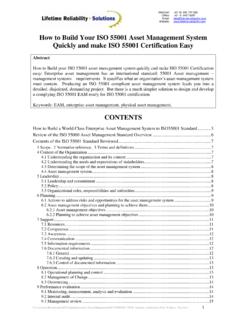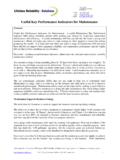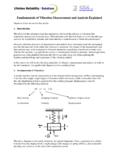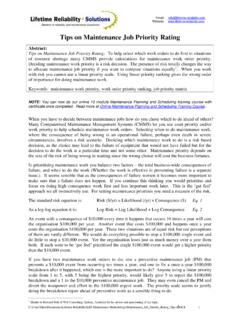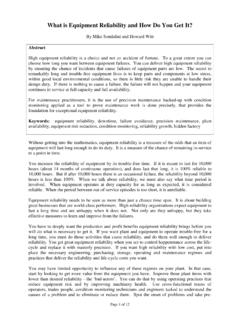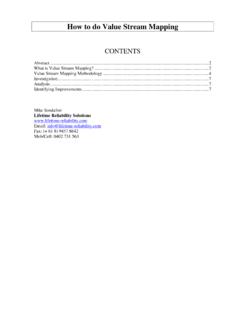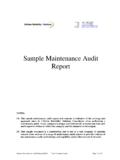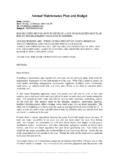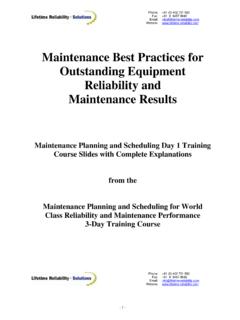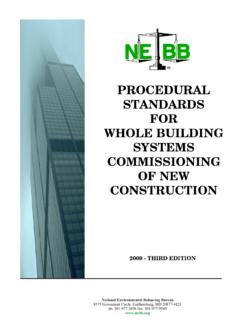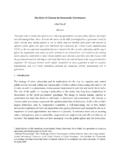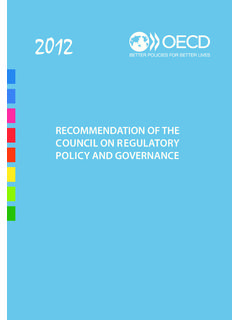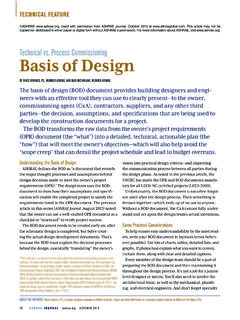Transcription of Equipment Criticality Tutorial - World Class Reliability
1 Phone: Fax: Email: Website: +61 (0) 402 731 563 +61 (8) 9457 8642 Equipment Criticality Tutorial This is a brief Tutorial on doing an Equipment risk assessment to identify Equipment Criticality . It is a summary of the complete Operating Risk Assessment Tutorial available to buy at the Lifetime Reliability Solutions online Web store. Developing an Equipment risk profile is known as Equipment Criticality . It uses the risk formula to identify the business financial impact if an Equipment failure was to happen it is a risk rating indicator.
2 Equipment Criticality = Failure Frequency (/yr) x Cost Consequence ($) = Risk ($/yr) The cost consequence is usually the costs of lost production plus the costs of repair which, Defect and Failure True Costing warns us, is often well short of the true business-wide cost. The failure frequency is from the company s maintenance history, or industry norms for a similar situation. Standard Equipment Criticality is also used to rate Equipment in priority order of importance to the continued operation of a facility.
3 Equipment that stops production, or that causes major production costs when failed, is considered most critical. Once Criticality is known the facility s resources, engineering effort, operations practices, maintenance and training are matched to the priority and importance of the item s continued operation. The Plant and Equipment Wellness approach to Equipment Criticality differs from the standard approach by using the business-wide Defect and Failure True (DAFT) Costs, and not only production impact, to gauge business risk from Equipment failure.
4 A key premise of the Plant and Equipment Wellness is that we are building a World - Class business, and to make the right business decision it is necessary to know the business-wide losses, and not simply the production losses, of a failure. Unless the true and total business-wide costs are included in determining Equipment Criticality , the full risk of an Equipment failure to the business is not recognised. Using DAFT Costing gives a more accurate value of consequential loss to the whole business and so a truer business risk is determined.
5 A competent team of people is drawn together to identify the Equipment Criticality for a facility. Normally a database of DAFT Costs is first developed. The database is used to populate calculation spreadsheets and makes the analysis quicker and easier. Typically the review group consists of the operators, maintainers and designers of the plant who contribute their knowledge and experience. The group reviews drawings of the facility s processes and its Equipment . Equipment by Equipment they analyse the consequences of failure to the operation and develop a table showing each equipments Criticality rating.
6 It is the practice that the final arbiters of a choice are the Operations or Production Group, since they must live with the consequences and costs of a failure. Phone: Fax: Email: Website: +61 (0) 402 731 563 +61 (8) 9457 8642 Risk Matrix Calibration The persons involved with the risk assessment need to - a. Understand the Equipment operation and design operator manuals, maintenance manuals and design drawings contain this information. b. Understand the impact on production of losing the Equipment . The information is in plant drawings, Process Flow Diagrams (PFD), Process and Instrumentation Diagrams (P&ID).
7 C. Know the business-wide financial loss from a forced outage. The DAFT Cost losses for a typical downtime period must be quantified. d. Know the effects on business reputation and the impact on Clients of forced outages. e. Review and adopt the risk control methodology in international risk management standards, such as ISO 31000 Risk Management, or its other international equivalents. f. Calibrate the consequences on the Risk Matrix using the information developed from the above and the advice of experienced and senior persons in the operation under review.
8 Asset Assemblies and Components In order to understand the knock-on consequences of failed assemblies in the Equipment , whose failure may have little effect or may contribute major cost, each asset is subdivide into its major assemblies. If major assemblies contain substantial numbers of individual Equipment , then these are further divided into sub-assemblies. Risk Assessment The Risk Identification and Assessment Template is used to find and list the operating risks to each Equipment , assembly and sub-assembly.
9 Alternately, a spreadsheet is developed to replace the template. The risk matrix shown in Table 1 is an example and you will need to develop a risk matrix specifically applying to your business. For Equipment and assemblies under assessment use the calibrated Risk Matrix to categorise Consequence (1-5), Likelihood (1-6) and Risk Level (L, M, H, E) from each risk. Risk Management For High and Extreme Risk Levels use the Risk Treatment Schedule and Action Plan Template to list actionable activities that will reduce risk by at least two levels.
10 For Medium Risk Levels identify actions that will reduce them to Low. A Failure Mode Effects Analysis or Reliability Growth Cause Analysis is used to identify required risk management activities to sufficiently lower the risk levels of individual parts. Phone: Fax: Email: Website: +61 (0) 402 731 563 +61 (8) 9457 8642 The Risk Matrix Knowing the consequence and frequency allows development of a risk ranking table for an operation. Table 3 is a risk matrix used to gauge the level of risk in a business.
